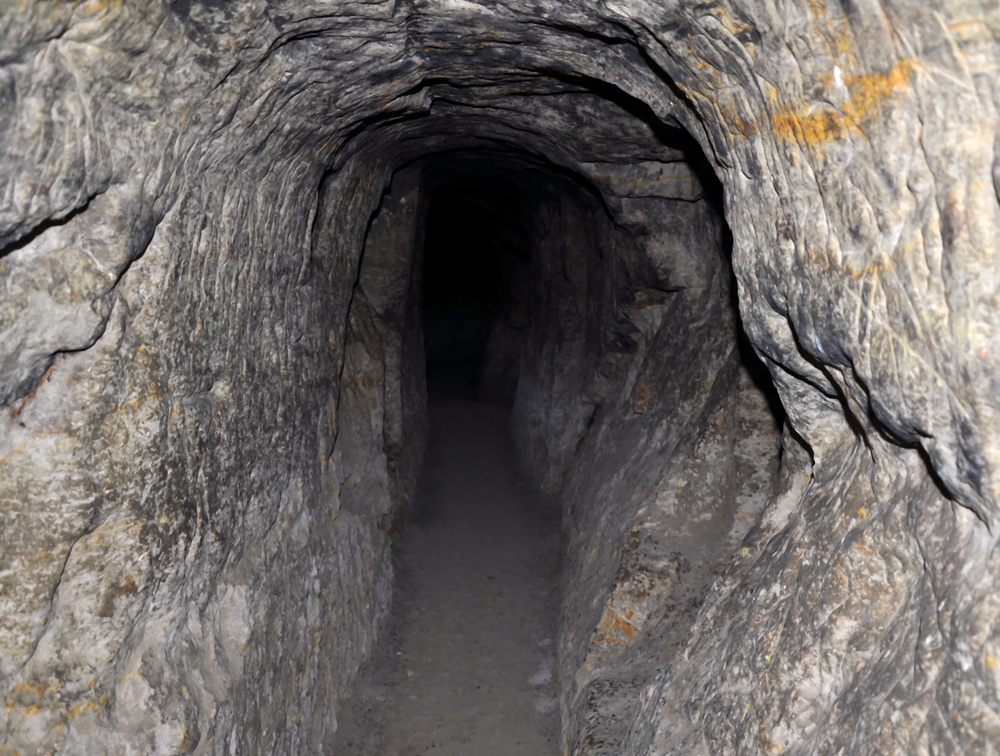
You might think that tunnels are always built by professionals, with an obvious and practical purpose — to transport people, to reach a deposit of coal or diamonds, to transport water, and so on. For some, however, digging a tunnel is a hobby, a distraction, an escape, a way of expanding their houses underground or even a way to exercise — we look at some of the tunnels built by ordinary people around the world.
1. Elton Macdonald

Discover B2B Marketing That Performs
Combine business intelligence and editorial excellence to reach engaged professionals across 36 leading media platforms.
When a Toronto conservative officer found a tunnel in the Driftwood Court district, the world was perplexed. The tunnel was skillfully constructed, braced and camouflaged, featuring water-resistant electric lights and a sump pump to suck up ground water leakage. As police were calling the author of the tunnel to come forward, the unexpected hole triggered speculation that it was built for terrorism purposes. It didn’t come as a surprise that the tunnel made into the news and that the hashtag #terrortunnel was used to describe it on Twitter.
The mystery, however, was solved when Elton Macdonald, a 22-year-old construction worker, broke the news that he was the tunnel’s creator. Macdonald had wanted to be a builder since he was a little boy, and what better way to improve his skills than building his own tunnel.
He succeeded in 2013, after four failed attempts. He found the right spot after carefully examining the soil and set his plan using discarded beer bottles and a tape measure: the tunnel would go 10m north with two rooms, one on either side. To dig he used a shovel, a pickaxe and a ladder.
The tunnel was built for “personal reasons”, the police said. Even Macdonald couldn’t really explain why he kept digging. “Honestly, I loved it so much. I don’t know why I loved it,” he told Macleans. The authorities have now filled and closed the tunnel.

US Tariffs are shifting - will you react or anticipate?
Don’t let policy changes catch you off guard. Stay proactive with real-time data and expert analysis.
By GlobalData2. Manuel Barrantes
A family home like this one is hard to find: Manuel Barrantes, known as the ‘Mole Man’, built an underground home for his family to escape noise pollution, climate change and natural disasters. The 63-foot-deep construction, it is said, was made only with a pick and a shovel. The 186sq m warren was carved through volcanic rock and red soil.
The most impressive feature of the hobbit-like-home is the hand-painted and decorated tunnels. The artwork includes the Flintstones, and family ornaments such as CDs, phones, photographs and money that have been attached to the rocky surfaces. One of the most peculiar creations is a painted skeleton found on one of the walls.
The home comprises bedrooms with stone beds, nine windows, conference rooms, and wells with crystal-clear water, baths and showers. The area is powered by electricity and there is also a telephone landline.
The Costa Rican man spent 12 years constructing what is now called ‘Topolandia’, not only a residence but also a museum. Even though his house is already huge, he wants to continue digging, joking that he might dig his way to China one day. Tours of the site are available and can be arranged with the ‘Mole Man’.
3. Leonid Murlyanchik
Calling all pensioners: what about spending your free time and pension money in building your private underground metro? This is exactly what Russian man Leonid Murlyanchik set about building in his backyard. Murlyanchik, who used to work on the railways, felt that his town, Lebedyan, was lacking a subway — so he decided to build one. The adventurous work started in 1984 and the initial plan was to dig a 6km tunnel to visit Ekaterina, a woman he liked in a neighbouring village. This was intercepted by Ekaterina’s son who, after being released from prison, put a stop to the Russian’s romantic plans.
Undeterred, and underground, Murlyanchik continued digging and building a rail track, having all the necessary permits. The railway would connect the neighborhood, benefiting in his opinion not only him but everyone. “Of course, it’s for everyone. It’s not only for me, everyone needs it. All the people who live here or around here, or for visitors,” Murlyanchik told Australia’s ABC News during a December 2010 interview.
Murlyanchik worked on the underground construction nearly every day during 27 years, devoting many hours to this peculiar project, using only homemade tools including a homemade concrete mixer. In July 2011, he had completed 300m of the tunnel, expected to run four-person electric train cars, and was planning to install fire hydrants and a plumbing system to combat potential fires. Lifts connecting his neighbours’ houses to the network were also part of his plans —this is if them would agree with it— but were never put into practice. He supported all the financial expenses using the majority of his 7,000-ruble (US$250) pension. After all his efforts, he wasn’t able to finish his subway as he passed away in September 2011. The tunnel was then closed down.
4. Lyova (Levon) Arakelyan
Lyona Arakelyan found his divine mission on Earth, as he put it, after his wife asked him to build a simple potato cellar. Once he started digging, he wasn’t able to stop.
The Armenian man, aged 44 at the time of the construction, argues that he had visions and dreams in which a voice was telling him to continue digging, building and carving. He even said that one day, while in Russia, a phantom came to him and said: “You have an important job to do, you will live 96 years and images will appear in your eyes during those years that you need to repeat them exactly.”
He worked every day for approximately 23 years, up to 18 hours each day having little rest or sleep, using only a cutter and a hammer. The ‘Divine Underground, as it’s now known has stairs, halls, twists and six rooms that go 70ft deep bellow Arakelyan’s house, through hard basaltic rock. Besides this, the amazing tunnels and walls are carved with stones and even sculptures which were hand-made by the construction builder. He says he didn’t do it all alone: “Almighty God helps me, I couldn’t do all this alone, I am just realising His work.”
Arakelyan died in 2008, with the Divine Underground now open as a museum.
5. “Hackney Mole Man”
William Lyttle or as he became known “Hackney Mole Man” started digging in the 1960s to add a wine cellar to his house, and didn’t stop for 40 years. The web of tunnels and caves were only discovered by the council following a series of complaints from his neighbours. The council’s ultrasound scanner uncovered tunnels and caves 8m deep, spreading 20m in every direction from his house.
Marc Beishon, one of Lyttle’s neighbours, said toThe Guardian: “I often used to joke that I expect him to come tunneling up through the kitchen floor.” Lyttle, on the contrary, was certain that he didn’t burrow under his neighbours’ houses; he had only done 40 years of “home improvements” and just has “a big basement”.
It is estimated that the Mole Man took 100cb m of earth from beneath roads and houses surrounding the Victorian property. In 2006 Lyttle was temporarily evicted from his house to allow engineers to fill the holes with cement, with an estimated cost of £100,000 that he would be billed for. Lyttle died in 2010, leaving the council with a bill of over £400,000. The house went to auction in the following year and sold for £1.12M.
6. Leanne Wijnsma
Leanne Wijnsma, a graphic designer living in Amsterdam, started digging tunnels in 2013 after she felt an instinct to do so.
“I just want to dive into the ground. I just want to be an animal, really autonomous like an animal. Sure, we are free, but we are free behind our computers. I just wanted to dig,” she explained in an interview to Vice magazine.
Still digging today, Wijnsma creates her tunnels in public places. She starts by marking the spot it will start and the point it will end with a small shovel. Her tunnels are between two and four metres long. Wijnsma has dug a total of 13 tunnels, in Germany, Italy, Belgium and South Africa.
“Escape is an action triggered by the paradox of freedom,” said Wijnsma. “The tunnel doesn’t lead to freedom. You’ll see that the tunnel ends just a few metres from where it starts. The choice to dig, however, becomes the freedom itself”.
Future plans include the burrow of new tunnels and the exploration of 3D images of them.
7. Harrison G. Dyar
Trying to find a new way to exercise? Harrison Dyar had the answer: start digging tunnels. The entomologist built a series of tunnels under his house near 21st and P streets NW, in Washington, as a way to exercise. “Some man play golf. I dig tunnels,” he said.
The tunnels were burrowed between 1906 and 1916, but were only found in 1924, when a truck’s tires sunk into the ground and revealed the entrance to the underground construction. The finding led to much speculation, until Dyar came forward as the architect.
The tunnels were high enough and broad enough for a man to walk inside and the walls were artistically made with white bricks. A mysterious feature which no one could explain are the numerous German newspapers on the ceilings of the tunnels, dating from the summer of 1917 and 1918, as Dyar claimed he left the house and tunnels before those dates.
8. Henry T. Nicholas III
Some build tunnels and secret passages to give life to their illicit desires. Henry T. Nicholas III, president and chief executive of Broadcom Corporation and on the Forbes list of the world’s richest people, is said to have had rooms and a secret underground tunnel built in his Laguna Hills mansion. The tunnel was built behind a wooden panel and was disguised by skulls lit by candelabras. The contractors who helped build what they call a ‘lair’ allege that the tunnel was intended to be a place where Nicholas could engage with prostitutes and take drugs.
“He wanted to live above ground with his wife and three children, with the option to go below ground to immerse himself in his cocaine, ecstasy, Viagra, speed, prostitutes, and party friends,” the contractors told Vanity Fair.
9. Hasso Herschel
Digging tunnels to cross the Berlin Wall, erected in 1961, was commonplace during the Cold War. Hasso Herschel helped dozens of people escape the communist regime in the east of Germany through secret tunnels, some of them built by him. His first tunnel was dug in September 1962; its entrance was hidden in a house’s basement on the eastern side of the border, on Bernauer Strasse. 29 people fled to the West using the tunnel.
Some of the illegal passageways were less than 100ft long and required people to crawl to cross them, while others were nearly 600ft in length, and big enough for them to stand up. Constructions built between 1961 and 1982 would take between three days and six months to finish. A total of 300 people are thought to have escaped through Herschel’s tunnels. Most of these passageways, it is believed, were dug using his hands or with whatever tools he would find.
In 1962, he was caught burrowing a tunnel with a friend by the police. His friend was killed and Herschel was badly injured. Herschel became, many years later, a guide to the tunnels system that is now a tourist attraction in Germany.





